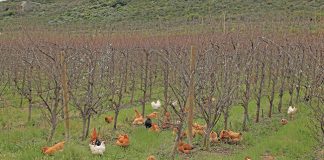In South Africa, eradicating invasive woody alien vegetation for alternative land use is normally a relatively heavy-handed method involving big drums of diesel or water and herbicide. This herbicide, mixed with water or diesel, is sprayed or painted onto cut tree stumps to prevent regrowth. However, this method is potentially disastrous for the environment because wind-drift and spillage is common, non-target species are affected and the soil around the felled trees is often contaminated.
A far more effective and environmentally friendly method involves a Swedish patent, locally manufactured by handicapped people in Gugulethu. Called the Ecoplug, it’s hammered into the tree stump after a hole has been drilled into it, and contains biodegradable glyphosate granules. The plug cracks when hammered into the stump and the granules quickly dissolve in the sap, spreading the glyphosate to the roots through the stump’s capillary system.
The chemical is applied exactly where it’s needed and there is no spillage. According to inventor Hans Merving, Ecoplug reduces the amount of chemical used by 90% to 95%, compared to the liquid chemical required for the same area when applied by spraying. “The surrounding environment is protected against chemical spillage and against root and stump sprouting,” he explains, adding that spraying has to be repeated two to four times for total control, but with Ecoplug just one application is needed. Wine and olive farmer Reni Hildenbrand is currently using this technology to clear an apricot orchard to make way for olives. Known for her environmentally friendly approach to farming, is very satisfied with Ecoplug.
“It takes about two months to kill a tree and I don’t have to expose my land to dangerous chemicals,” she says. Mike Brett, an environmental consultant previously with the National Parks Board, says riparian zones are especially sensitive areas where use of the Ecoplug in alien clearing makes sense. “With riverbanks there is always the chance of contamination. workers carry open canisters and spillage is a real threat. Buckets and applicators are often washed in the river if supervision isn’t adequate.” H e explains that mountain catchments are also problematic. “It’s difficult to lug 25â„“ cans of herbicide up the mountain. If there’s not enough supervision, the workers simply cut down the trees, but don’t spray them when the herbicide runs out because they don’t want to walk back so far, making the exercise futile.
A pouch full of Ecoplugs and a hand applicator are much easier to handle in mountain catchments and difficult terrain than drums of chemicals. he are more expensive than the diesel-and-herbicide method, but Brett asks a very relevant question: “What is cost-prohibitive to the environment? We don’t know the long-term effect of raw herbicide spillage in the name of alien clearing, which is supposed to be an environmentally friendly action.” n the retail trade, Ecoplug sells at R65 for 15. In bulk, it costs R1,75 per plug for 10 000 plugs.
The number of plugs required depends on the size of the tree. A small sapling with a diameter up to 5cm requires one plug inserted into a hole drilled into the cross-section of the cut trunk , whereas a tree with a 25cm diameter, would need five plugs inserted around the base of the tree, as close to the ground as possible. Merving says the most effective method to insert the plug is to use a petrol-driven drill to make holes in the flat plane of the cut stump or, in the case of standing trees, to drill holes close to the ground from the side. Application time is approximately 10 seconds per plug.
Contact Auriel Mitchley (011) 889 0796 or e-mail [email protected].













